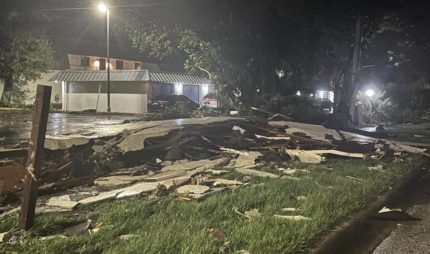Hurricane Milton made landfall in Florida on Wednesday night, unleashing devastating 120 mph winds and record flooding that wreaked havoc across the state. One of the most dramatic moments came when the storm destroyed the roof of the Tropicana Field stadium, home of the Tampa Bay Rays, which had been serving as a shelter for first responders and cleanup crews. Footage from inside the stadium showed debris scattered across the field, alongside empty cots intended for emergency workers.
In addition to the destruction of the stadium roof, Hurricane Milton also spawned deadly tornadoes, leaving a path of devastation in its wake. Over 100 homes in St. Lucie County were leveled, resulting in multiple fatalities. As the storm moved inland, it caused widespread flooding, power outages, and infrastructural damage, leaving nearly three million people without power across Florida.
Tornadoes and Flooding Compound Disaster
The intense winds of Hurricane Milton triggered several powerful tornadoes that caused extensive damage in southeastern Florida. St. Lucie County was hit particularly hard, with over 100 homes reduced to rubble, and numerous residents injured or killed. The region was left in a state of emergency as rescue workers scrambled to provide aid to those affected.
In St. Petersburg, the Hurricane Milton caused additional destruction when a massive construction crane collapsed, crashing into the offices of the Tampa Bay Times. Although no injuries were reported from the incident, the crane had been part of one of the tallest buildings on Florida’s west coast. The damage, combined with over 16 inches of rainfall, led the National Weather Service to issue flash flood warnings, particularly as rain levels in some areas exceeded the monthly average for October in just a few hours.
Tropicana Field’s Roof Destroyed Amid Hurricane Milton 120mph Winds
Tropicana Field, the stadium for the Tampa Bay Rays, suffered catastrophic damage when Hurricane Milton’s ferocious winds tore the roof off the facility. The stadium, which had been designated as a shelter for first responders and cleanup workers, was left exposed to the elements. While no injuries were immediately reported, the destruction inside the stadium was significant, with debris scattered across the field. The Florida Division of Emergency Management had set up a 10,000-person base camp at the site to coordinate debris removal operations.
The 34-year-old stadium, which cost $138 million when it opened in 1990, is due to be replaced by a $1.3 billion ballpark by 2028. However, the damage inflicted by Hurricane Milton highlights the vulnerabilities even modern structures face in the path of such powerful storms. Officials are working to assess the full extent of the damage and determine whether the stadium will remain operational for emergency purposes.
Widespread Power Outages and Ongoing Storm Threat
As Hurricane Milton swept across Florida, it left nearly three million residents without power, plunging large parts of the state into darkness. The power outages were accompanied by significant infrastructure failures, including water main breaks in St. Petersburg, which led city officials to shut down all drinking water services. A citywide boil-water notice was issued, and repairs were expected to take several days due to the ongoing hazardous conditions.
While Hurricane Milton has been downgraded to a Category 1 storm, the threat is far from over. Wind gusts exceeding 100 mph continue to batter parts of Florida, and flooding remains a significant concern. Emergency services in cities like Orlando have been suspended as officials brace for further impacts. Scientists have described the event as a “one in a thousand years” storm, highlighting its unprecedented scale and the long recovery process that lies ahead for Florida.














